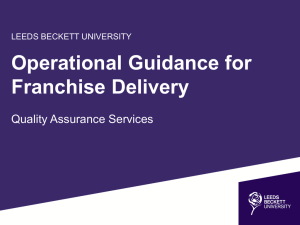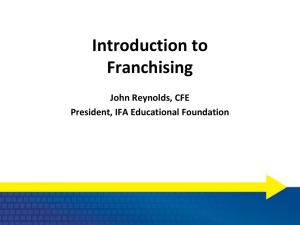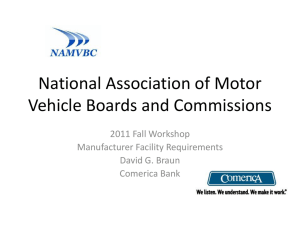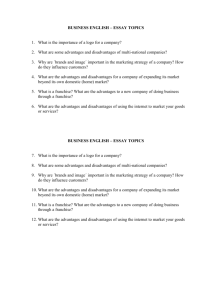THE STRUCTURE OF A FRANCHISE DISCLOSURE DOCUMENT
advertisement
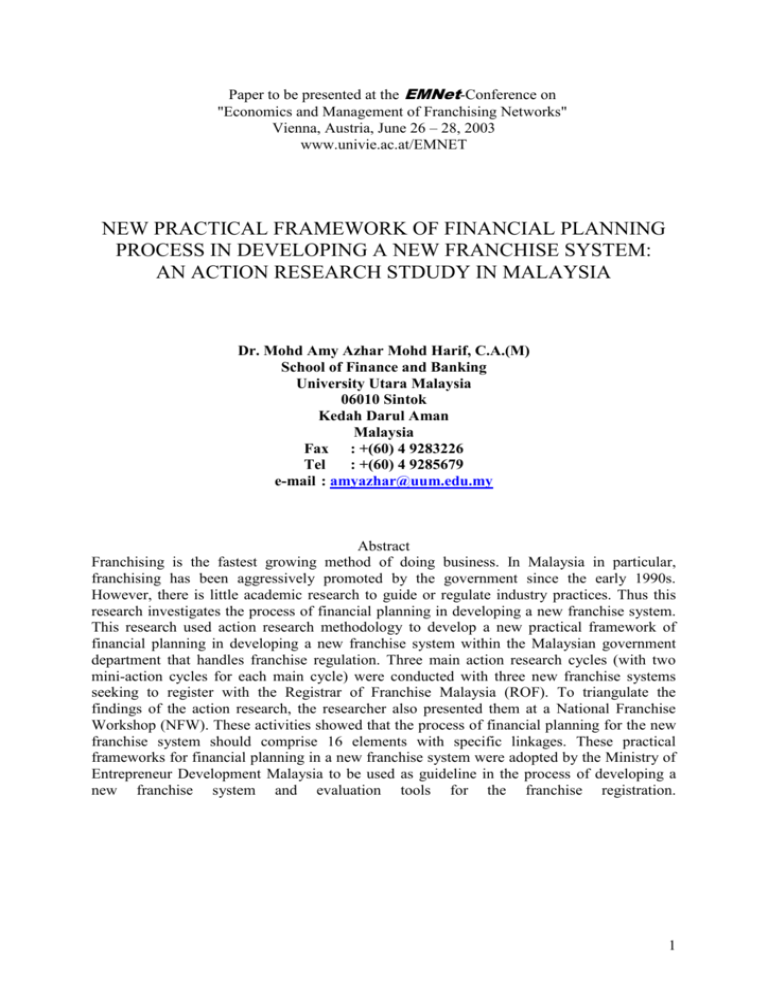
Paper to be presented at the EMNet-Conference on "Economics and Management of Franchising Networks" Vienna, Austria, June 26 – 28, 2003 www.univie.ac.at/EMNET NEW PRACTICAL FRAMEWORK OF FINANCIAL PLANNING PROCESS IN DEVELOPING A NEW FRANCHISE SYSTEM: AN ACTION RESEARCH STDUDY IN MALAYSIA Dr. Mohd Amy Azhar Mohd Harif, C.A.(M) School of Finance and Banking University Utara Malaysia 06010 Sintok Kedah Darul Aman Malaysia Fax : +(60) 4 9283226 Tel : +(60) 4 9285679 e-mail : amyazhar@uum.edu.my Abstract Franchising is the fastest growing method of doing business. In Malaysia in particular, franchising has been aggressively promoted by the government since the early 1990s. However, there is little academic research to guide or regulate industry practices. Thus this research investigates the process of financial planning in developing a new franchise system. This research used action research methodology to develop a new practical framework of financial planning in developing a new franchise system within the Malaysian government department that handles franchise regulation. Three main action research cycles (with two mini-action cycles for each main cycle) were conducted with three new franchise systems seeking to register with the Registrar of Franchise Malaysia (ROF). To triangulate the findings of the action research, the researcher also presented them at a National Franchise Workshop (NFW). These activities showed that the process of financial planning for the new franchise system should comprise 16 elements with specific linkages. These practical frameworks for financial planning in a new franchise system were adopted by the Ministry of Entrepreneur Development Malaysia to be used as guideline in the process of developing a new franchise system and evaluation tools for the franchise registration. 1 Introduction Franchising is the fastest growing method of doing business (Miranda 1995) and has become the most important and popular method of creating new businesses (Justis 1995). Franchises contribute about 10 percent of the world’s Gross Domestic Product (GDP) and 14 percent of the world’s total retail sales (Mendelsohn 1995; Mendelsohn 1999). Indeed, franchising contributed 49 percent of the United States’ total retail sales, and 30 percent of the United Kingdom’s and Europe’s (Baucus & Baucus 1997; Mendelsohn 1999; Sherman 1995; Swartz 1995). Many countries have laws affecting this franchising. For example, the United States has precontract disclosure documents (Mendelsohn 1999) and France, Spain, Brazil and Mexico have pre-contract disclosure laws. The United Kingdom implemented a Trading Scheme Act in 1996 and Russia has enacted a set of regulation affecting franchising. Italy has recently proposed a bill to regulate franchising (Mendelsohn 1999). Australia has now introduced a Franchising Code of Conduct. In turn, in Malaysia where this research was conducted, the government has promoted the Malaysian’s franchise industry aggressively since 1992 (Adzmi 1999) and it has experienced rapid development. The Malaysian Franchise Act 1998 was introduced to protect the franchise industry, and requires registration of every new franchise system. In general, franchising is an under-researched area that is not well understood and the sector suffers from a lack of reliable information (Dyl 1991; Frazer 1998; Katz & Owen 1992; Welsh 1996). This lack is especially evident in Malaysia (Mohd Ali 1995). The Malaysian Government under the Franchise and Vendor Development Division, Ministry of Entrepreneur Development, Malaysia (Kpun), has offered research grants to conduct research 2 in the franchising area. Some higher education institution and consultants have conducted preliminary studies (Franchise and Vendor Development Division 1999). However, there has been no empirical research about the process of financial planning (confirmed through searches of ABI Inform, EBSCO, Emerald, and Kpun databases). A financial planning is a core part of setting up a franchise because it provides information to a prospective franchisor that he or she needs to make a decision about opening and operating a new franchise system. This research about this financial planning process will reduce the risk of failure by improving the franchise planning process. Hence, the aim of this research is to develop an effective conceptual framework for financial planning in developing a new franchise system. That is, this paper addresses the problem: What should be the elements of financial planning in developing a new franchise system? This paper has three sections. Firstly, a preliminary framework based on the literature is outlined. Then the methodology of action research is briefly discussed. Finally, a final framework from the action research project is presented. A Preliminary Framework A preliminary framework to guide this research was developed from the literature about the process of financial planning in developing a new franchise system in developed nations and in Malaysia in particular. Entrepreneurs who want to develop and operate a franchise system in Malaysia must obtain approval from the Registrar of Franchise (Malaysia Franchise Act 1998), as noted above. The new franchisor needs to prepare a financial planning along with 3 other documents (Franchise and Vendor Development Division 1999), for submission with an application form for review by the Registrar of Franchise (Bustaman 1995; Miranda 1995). Financial planning in developing a new franchise system Except for Justis and Judd (1998) Mat Hassan (1998) and Abdul (1995), there is a gap in the literature about how the elements should be developed in the financial planning of a new franchise system by the potential franchisor and this research had to establish these new franchise system financial planning elements. As well, it had to identify linkages between the elements because that had not been done in the literature. We developed preliminary, very comprehensive list of financial planning elements of a new franchise system from various Western and Malaysian sources, as shown in Table 1. Figure 1 emphasises the linkages and the flow of financial planning process that had to be made explicit in this research: in preparing the pro-forma annual balance sheet, it will use the information from the existing balance sheet as an opening balance (line a in figure 1), operating budget (line b in figure 1), capital budget (line c in figure 1), cash flow projection (line d in figure 1), and pro-forma annual income statement, the information from the operating budget will be used in preparing the pro-forma annual income statement (line e in figure 1), 4 cash flow projection is also helpful to a franchisor in identifying whether the franchisor needs to source outside financing in developing and operating the franchise system (line f in figure 1), the ratios are designed to compare the current business activity (before franchising) using the existing financial statements (line i in figure 1) with the pro-forma financial statements (lines g and h in figure 1), and the start-up or turnkey costs to open a franchisor’s outlet will be used in preparing the capital budget (line j in figure 1). Twelve elements of financial planning ten linkages should be included in the process of developing the new franchise system and they will be used for this research. The next step was to investigate if those 12 elements and 10 linkages were in fact necessary, feasible or desirable in the real world of Malaysia. 5 Table 1 No 1 2 The elements of new franchise system financial planning B C Elements of financial planning in A developing franchise system Existing financial statements (statements from the establish business) Identify franchise development costs Total This research - 3 - 2 - 2 3 - - 2 - - 2 5 Franchise start-up or turnkey cost for the franchisor and franchisee to begin the franchise system Franchise fees (initial fee, continuing fee, and advertising levy) Operating budget (monthly) 6 Capital budget (monthly) 7 4 8 Cash flow budget (monthly basis) and cash flow projections statement (yearly basis) Pro-forma annual income statement 4 9 Pro-forma annual balance sheet 4 10 Break-even analysis - 3 11 Financial ratio analysis - 3 12 Financing 4 9 8 3 4 Total 10 12 Legend: A = Justis & Judd (1998) B = Abdul (1995) C = Mat Hassan (1998) Source: developed for this research 6 Figure 1 The flow of financial planning process in developing a new franchise system, emphasising the linkages between elements 1. The existing financial statements 2. Identify franchise development costs 3. Franchise start-up or turnkey cost 4. Franchise fees 5. Prepare operating budget (monthly) 10. Break-even analysis 11. Financial ratio analysis 6. Prepare capital budget (monthly) 7. Prepare cash flow budget (monthly) and cash flow projection (yearly) 8. Prepare a pro-forma annual income statement 9. Prepare a pro-forma annual balance sheet 12. Financial position and financing(capital) Legend: a-i = direct linkages (the direct linkages are function as information provider to the related elements) Source: developed for this research from the literature cited in table 1 7 Methodology This research seeks to explore a little-researched area, as noted, that is, the research is necessarily theory-building rather than theory-testing. Thus it was appropriate to use a qualitative methodology to obtain a ‘window’ on to the complex processes of developing a franchise disclosure document in a new franchise system in Malaysia (Carson et al. 2001). Action research was the qualitative method used, mainly for access reasons. For example, case studies of franchisors, franchisees or consultants could not be obtained because the financial matters in a franchise system in Malaysia are complex and deal with confidential elements. Nevertheless, access to three prospective franchisors and their financial plans was eventually obtained through a group of regulators within the Franchise and Vendor Development Division, Ministry of Entrepreneur Development, Malaysia. That is, the research involved the researcher in participative and collaborative research in the best site in Malaysia to investigate the planning processes of the many would-be franchisors who have to apply for registration with the division. Action research is practical, participative, collaborative, interpretive and critical in its handling of a research problem (Perry & Zuber-Skerritt 1990). More precisely, in this research, a cyclical process methodology was used that incorporated the process of planning, acting, observing and reflecting on results generated in the workplace to increase the understanding of participants in a workgroup (called the policy workgroup) and others within an organisation (at a National Franchise Workshop towards the end of the research project), and produced a public report of those experience that became the guide for developing a franchise disclosure documents in the government department (based on Altrichter (1990), 8 Altrichter et. al. (2000), Bawden & Zuber-Skerritt (2000), Cherry (1999), Dick (1992), Dick (2000), Kemmis & McTaggart (1988), Kolb (1984), Lewin (1946), O’Leary (2000), Passfield (2000), Perry & Zuber-Skerritt (1992), Rapoport (1970), Revans (1991), and Zuber-Skerritt & Perry (2000). The action research process for this research consisted of three stages: reconnaissance, twomini action research cycles with the three firms in developing a new franchise system (cases), and a triangulation workshop, as summarised in Figure 2. Stage one of reconnaissance consisted of: A literature review to increase understanding of the processes. The researcher reviewed the internal and external sources (both documentary and personnel) to ascertain existing knowledge within the Ministry of Entrepreneur Development Malaysia, franchise consulting companies, and other relevant entities. Convergent interviewing was done with five experts about the franchise industry in Malaysia (Carson et al. 2001). 9 Figure 2 The procedure of action research project for this research Stage one: reconnaissance about problem content Stage two: two-mini 2 Act action research cycles for each of the 1.1 1 plan 1.2 3 Observe 2.1 3.1 2.2 3.2 three firms (cases) 4 Reflect Case 1 Case 2 Case 3 Final phase of stage two: triangulation workshop (National Franchise Workshop) Legend: 1.1 and 1.2: two mini-action research cycles in a new franchise case 1 2.1 and 2.2: two mini-action research cycles in a new franchise case 2 3.1 and 3.2: two mini-action research cycles in a new franchise case 3 note: the cycle in each case was a combination of two mini action research cycles Source: developed for this research Stage two was two-mini action research cycles with three would-be franchisors applying to register their systems. Six officers were included in this action research project to work with the researcher in what was known as a policy workgroup. Stage three was a National Franchise Workshop used to triangulate the findings of stage two (Burgess 1984). More than 100 participants attended this workshop. The participants were people directly involved in the franchise industry, such as franchisors, franchisees, bankers, franchise consultants, representatives from Malaysian Franchise Association (MFA), representatives from Ministry of Entrepreneur Development, and representatives from higher education institutions. Thus they represented experienced experts, others thinking of creating or buying franchise business, and the financiers and consultants who resource or advise 10 current and potential entrepreneurs, franchisees and franchisors. The researcher moderated the workshop and the other members of policy workgroup acted as observers. Findings Findings from this action research project extended the preliminary framework that has been developed based on the literature, to provide two conclusions. To begin, the findings of this research added another two elements of financial planning to the original twelve elements of developing a new franchise system in table 1. Firstly, the payback period analysis of the new franchise system must be included in the process of financial planning in developing a new franchise system because it is an element of financial planning that could be used to monitor the financial plans of a new franchise system in Malaysia and it helps a franchisor to forecast the duration of getting the total investment of a new franchise system. Secondly, the safety margin analysis must be included too because it is an element of financial planning that could be used to monitor the financial plans of a new franchise system in Malaysia and it can help the franchisor to indicate the level of the franchise operation to continue the business operation in the worse case scenario. Using payback period and safety margin analysis for this purpose were discovered for the first time by this research because of the processes of the action research project. These two additional elements in financial planning in developing a new franchise system had not been considered for financial planning of a new franchise system before and so are contributions of this research. 11 The second conclusion, the ten linkages in the financial planning process of developing a new franchise system had not been discussed in the literature. This research had included the linkages in the conceptual framework. The findings of this research also confirmed for the first time the using of all the ten linkages in the financial planning process of developing a new franchise system. This research discovered the using of the linkages because of the collaboration between the new franchisors and the members of workgroup in the action research project and the aim to produce a high standard of financial planning. In summary, 14 elements of financial planning and 10 linkages within the elements of financial planning are to be used in the process of developing a new franchise system in Malaysia. No other research has examined the process of financial planning in developing new franchise system as precisely or as broadly as this research, especially in Malaysia where only minimal literatures exist. Conclusion There is little research about the process of financial planning for a new franchise system in Malaysia. The practical framework developed in this research, the elements of financial planning for a new franchise system is identified based on the western and Malaysian literature, that is, all the elements of financial planning are considered to be used in the financial planning for a new franchise system with two additional elements. This paper not only contributed to the body of knowledge about the effective framework of financial planning for both new franchise system and new venture business but it also has implications for policy and practice: it produced guidelines for franchise evaluation that were adopted by Registrar of Franchise Malaysia (ROF), the guidelines could be used to build 12 franchise guideline in other developing countries and even in developed countries like Australia and New Zealand, the guidelines also could be used by business consultant in strengthening the process of developing the franchise system, and the bankers could use this framework in updating the evaluation guideline of financial planning characteristic for business financing. The guidelines also provide a platform for comprehensive training, and show existing franchise systems how to improve their financial planning system. Moreover, the paper provides another example of the power of the action research methodology. Further research could consider how the findings could be used in other countries, cultures and regulatory contexts. 13 14 List of References Abdul, K. M. (1995). Financing your franchise. Paper from the proceedings The Second Malaysian International Franchise Conference & Exhibition, Kuala Lumpur. Adzmi, A. W. (1999). Malaysian-Gateway to Asian Franchising. Malaysia Franchise, (MayJune), 6-7. Altricther, H. (1990). Do We Need an Alternative Methodology for Doing Alternative Research?. In O. Zuber-Skeritt (Eds.), Action-Research For Change and Development, Center for the Advancement of Learning and Teaching. Altrichter, H., Kemmis, S., McTaggart, R. & Zuber-Skerritt, O. (2000). The Concept of Action Research. Action Learning, Action Research and Process Management: Theory, Practice, and Praxis, Action Research Unit, Faculty of Education, Griffith University, Brisbane, Australia. Baucus, D. A., & Baucus, M. S. (1997). Variations in Base Fees and Royalties in Franchising Contracts. Franchising Research: An International Journal, 2(1), 15-31. Bawden, R. & Zuber-Skerritt, O. (2000). The Concept of Process Management. Action Learning, Action Research and Process Management: Theory, Practice, and Praxis, Action Research Unit, Faculty of Education, Griffith University, Brisbane, Australia. Burgess, R.G. (1984). In the Field: An Introduction to Field Research. George Allen and Unwin Ltd, London. Bustaman, A. (1995). Legal Issues on Franchising in Malaysia. Paper from the proceedings of The Second Malaysia International Franchise Conference & Exhibition, Kuala Lumpur. Carson, D., Gilmore, A., Perry, C. and Gronhaug, K. (2001). Qualitative Research in Marketing, London: Sage. Cherry, N. (1999). Action Research: A Pathway to Action, Knowledge and Learning, RMIT University Press, Melbourne. Dick, B. (1992). You Want to Do an Action Research Thesis?. Interchange Document, University of Queensland. Dick, B. (2000). Postgraduate Programs Using Action Research. Action Learning, Action Research and Process Management: Theory, Practice, and Praxis, Action Research Unit, Faculty of Education, Griffith University, Brisbane, Australia. Dyl, E. A. (1991). Financial Issues in Franchising in Advances in Small Business Finance, Kluwer Academic Press, Netherlands. Franchise and Vendor Development Division (1999). Franchise Business in Malaysia: A Handbook, The Ministry of Entrepreneur Development, Kuala Lumpur. 15 Frazer, L. (1998). Motivations for Franchisors to Use Flat Continuing Franchise Fees. Journal of Consumer Marketing, 15(6), 587-597. Justis, R. T. (1995). What, Why and When Franchising? Global Trends in Franchising: USA & Europe. Paper from the proceedings of The Second Malaysian International Franchise Conference & Exhibition, Kuala Lumpur. Justis, R. T. & Judd, R. (1998). Franchising, Cincinnati South Western Publishing Company, United States of America. Katz, B. G. & Owen, J. (1992). On the Existence of Franchise Contracts and Some of Their Implications. International Journal of Industrial Organization, 10, 567-593. Kemmis, S. & McTaggart, R. (1988). The Action Research Planner, 3rd edition, Deakin University, Victoria, Australia. Kolb, D. A. (1984). Experiential Learning. Experience as the Source of Learning and Development, Prentice Hall, Englewood Cliffs, USA. Lewin, K. (1946). Action Research and Minority Problems. Journal of Social Issues, 2(4), 3446. Malaysia Franchise Act (1998). Franchise Act 1998, PNMB, Malaysia. Mat Hassan, E. (1998). PNS role in financing your franchise business. Paper from the proceedings of The Malaysia Franchise Exhibition & Conference, Kuala Lumpur. McMahon, Richard G. P. (1999). Financial reporting to financiers by Australian Manufacturing SMEs. International Small Business Journal, vol. 18 (1), OctoberDecember, 35-52. Mendelsohn, M. (1995). New Bank Franchise Finance Scheme Introduced in U.K. Franchising World, 27 (1), January/February, 69-70. Mendelsohn, M. (1999). The Guide to Franchising, 6 th edn., Casell, London. Miranda, G. (1995). Franchising An Overview, Malaysian Franchise Association, Kuala Lumpur. Mohd Ali, A. (1995). The Franchise Development Program in Malaysia: A Public/Private Sectors Synergy to Promote Bumiputera Participation in Franchising. Paper from the proceedings of The Second Malaysian International Franchise Conference & Exhibition, Kuala Lumpur. O’Leary, C. (2000). Integrating E-Business Information into the Database Marketing Processes of Australian Organizations: an action research analysis. DBA Thesis, University of Southern Queensland, Australia. 16 Passfield, R. (2000). The University of Queensland action research program: A parallel action learning structure. Action Learning, Action Research and Process Management: Theory, Practice, and Praxis, Action Research Unit, Faculty of Education, Griffith University, Brisbane, Australia. Perry, C. & Zuber-Skerritt, O. (1990). Action Research in Graduate Management Research Programs. Paper from the proceedings of The 2nd World Congress on Action Research and Process Management, Griffith University, Brisbane. Perry, C. & Zuber-Skerritt, O. (1992). Action Research in Graduate Management Research Programs, Higher Education, Kluwer Academic Publishers, Netherlands. Rapoport, R. N. (1970). Three Dilemmas of Action Research. Human Relations, 23, 499-513. Revans, R.W. (1991). The Concept, Origin and Growth of Action Learning. In ZuberSkerritt, O. (Eds.), Action learning, Action Research and Process Management, ALARPM/AEBIS Publishing, Brisbane, Australia. Sherman, A. J. (1995). International franchising: Strategies for Building Bridges Between Asia and North America. Paper from the proceedings of The Second Malaysia International Franchise Conference & Exhibition, Kuala Lumpur. Swartz, L. N. (1995). Worldwide Franchising Statistics: A Study of Worldwide Franchise Association, Arthur Anderson (in co-operation with the World Franchising Council). Timmons, J. A. (1999). New Venture Creation: Entrepreneurship For The 21st Century, McGraw-Hill, United States of America Welsh, D. H. B. (1996). Editorial. Franchising Research: An International Journal, 1(1), 3. Zuber-Skerritt, O. & Perry, C. (2000). Action Research in Graduate Management Theses. Action Learning, Action Research and Process Management: Theory, Practice, and Praxis, Action Research Unit, Faculty of Education, Griffith University, Brisbane, Australia. 17



